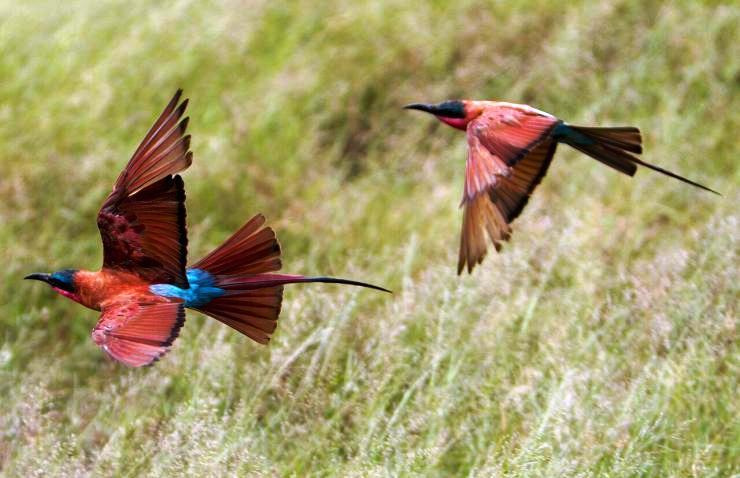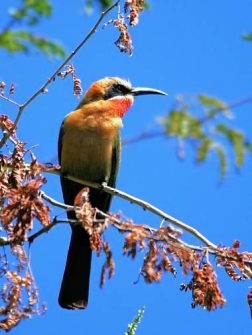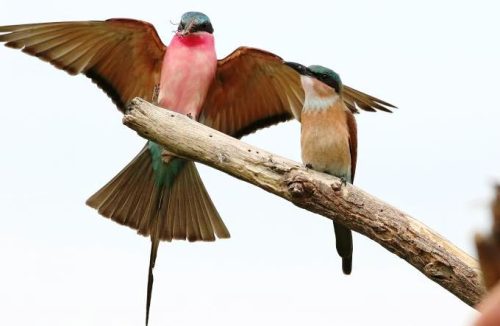The Bird that Colours the Zambezi River in Red.

When the flocks of the carmine bee-eater arrive in the Zambezi Valley, at the height of the dry season, the bush is tinged with the red colour of its feathers, brushing the arid colours of the winter landscape
with renewed brilliance.
It is already the middle of September, and the dry season is coming to an end: in the Zambezi Valley everything is parched and arid, and water is scarce in the few remaining pools. Only in the great perennial rivers does it continue to flow and refresh thirsty animals. But in this panorama of scorched and faded colours, suddenly the bush and the banks of the Zambezi River are tinged with red.
This is, in fact, the time in which a wonderful intertropical migratory bird with characteristic carmine plumage arrives in the wooded savannas of northern Zimbabwe to mate and nest, coming from northern South Africa and Mozambique, where it spends the winter – the southern carmine bee-eater (Merops nubicoides).

Adult White-fronted Bee-eater (Merops bullockoides)at the Zambezi near Livingstone, Zambia. CC BY-SA 4.0/Hans Hillewaert
It is a graceful bird with colourful plumage and ranges in size from 30 to 38 centimetres. Its dazzling colours are its main characteristic, making it unmistakable: the back and chest of adult specimens are red, as is the forked tail. The head and lower abdomen are instead blue, while a black band runs from the base of the beak to the ear area, creating a characteristic black mask, which probably attenuates the glare of light during hunting.
From a perched position on a branch near the colony, Bee-eaters identify the flying insects they feed on. From there they swoop down, taking flight and chasing their prey in admirable flying acrobatics that their long, thin wings allow them. When the prey is finally captured and held firmly in its beak, the bee-eater returns to the branch it left to consume its meal. If this consists of an insect with a stinger, such as bees or wasps, the bee-eater slams it repeatedly against the branch, with rapid head movements, until the stinger is removed.

Southern carmine bee-eater, Merops nubicoides, Chobe National Park, Botswana. CC BY 2.0/ Derek Keats
When these colourful birds arrive in the Zambezi Valley, their white-fronted bee-eater cousins have just weaned their clutches and abandoned the nests dug in the river banks. Carmines, which live in large colonies, occupy abandoned nests, clean them and prepare for their brood, where the female, after mating, lays two to five eggs.
Both parents take turns in brooding, which lasts about three weeks, and in the subsequent feeding of the chicks. After a month, the young bee-eaters are able to leave the nest and take flight. The chick feeding period is a time of intense hunting for the carmine bee-eaters and the skies above the Zambezi, at this juncture, are brushed with the red plumage of these graceful birds, engaged in their wonderful aerial acrobatics. (Open Photo: Two southern carmine bee eaters in flight. CC BY-SA 3.0/ Uncovery)
Gianni Bauce/Africa



